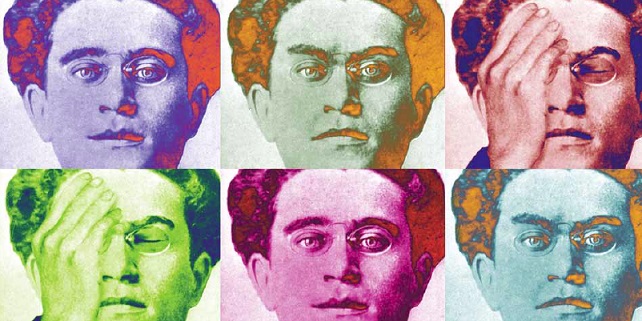However, the points of view of Althusser and Anderson are essentially divergent on a fundamental issue: whilst for Althusser the core question is to elaborate a critical ‘theory’ on the relations between Marxism, science and philosophy, without a clear strategic dimension, Anderson’s approach prioritizes the strategic question and locates critical theories in this context.
In this sense, the equating of Anderson with Althusser suggested by Thomas is contestable, although the polemic with Anderson on the question of the state is productive when reflecting on this topic from a Marxist perspective.
Thomas rescues and systematises the category of the ‘integral state’ presented in Gramscian texts, summarised in the following definition by Gramsci: “The state (in its integral sense: dictatorship + hegemony)” . This definition first appears in Q6 §10 in relation to the history of intellectuals and their relations with the emergence and crisis of the modern state. This is the context in which Gramsci says of the French revolution that the bourgeoisie “could present itself as the integral ‘state’, with all the intellectual and moral force necessary and sufficient to organise a complete and perfect society”.
Corresponding to the historical necessity of the modern (bourgeois) state to have a mass base, the category of the integral state, as understood by Thomas, permits a more complex reading of the state in the 20th Century (and in the present). On this point, Thomas uses the concept of the integral state to refute the three ‘models’ of the (oscillating and variable) relations between state and civil society in the ‘West’ that Anderson identifies in the work of Gramsci:
– State contrasts with Civil Society
– State encompasses Civil Society
– State is identical with Civil Society
Likewise, Thomas argues that by using the concept of ‘integral state’, “Gramsci attempted to analyse the mutual interpenetration and reinforcement of ‘political society’ and ‘civil society’ (to be distinguished from each other methodologically, not organically) within a unified (and indivisible) state-form”.
The Integral State, the Expanded State and the ‘statified’ trends
Against these three models, the Thomas proposal is to try to overcome any possible ‘oscillations’ and mutations undertaken by Gramsci in the distribution of coercion and consensus between state and civil society by arguing that the integral state represents precisely a new expression of the relationship between political society and civil society, so that the location of coercion or consensus on only one of the two poles is impossible.
Thomas argues that the category of integral state is closer to Gramscian texts than the ‘expanded state’ suggested in the classic book of Buci-Glucskmann, Gramsci and the State.
However, whilst it may be less philologically rigorous, the idea of an ‘expanded state’ (which Buci-Glucksmann summarizes as “an incorporation of the hegemony and the state apparatus” ), besides not being so dissimilar in its content to the proposal of Thomas, may prove useful ‘historically’ so long as it does not descend into a reading of the ‘contested State’ or of ‘fighting to change the state from within its ideological apparatuses’ (which does as much damage to Marxism as the benefits obtained by those who achieve official positions).
In other words, Gramsci’s idea that the State in its integral meaning as ‘dictatorship + hegemony’ does not speak to a static definition in which the states of the ‘West’ are inherently hegemonic (from the French Revolution onwards) but to a more complex process by which the State seeks a mass base while perfecting its repressive apparatus and extending its control over the organizations that ‘are not state’ in the strict sense, a tendency present in the nineteenth century, principally with the integration of the social democracy which leapt forward in the era of imperialism, as discussed below.
In this sense, Anderson’s critique, which Thomas does not especially take into account in his book, that “Paradoxically, however, Gramsci never produced any comprehensive account of the history or structure of bourgeois democracy in his Prison Notebooks” , could be seen as somewhat ahistorical, because Gramsci is thinking about the setbacks of the communist movement in societies that are much more complex than Tsarist Russia, but not at moments when bourgeois democracy is at its peak.
Gramsci’s reflections did not take place when ‘normal’ bourgeois democracy prevailed, but during reconfigurations of state forms in the ‘West’ intended to avoid the revolutionary eruption of the masses along the lines of the ‘Russian way’, and in this sense the bourgeois democracy of which Gramsci was thinking was characterised by the existence of trade unions and mass parties, in a context of strong Bonapartist tendencies in ruling regimes and a crisis of parliamentarism.
A theoretical overextension of concepts or an historical expansion of the apparatus?
Anderson argues that one of the most controversial points, never corrected by Gramsci in his three ‘models’ of the relation between the State and civil society, between coercion and consensus, is the overextension of the concept of the State, where equally to distribute coercion between the State and civil society dilutes the monopoly of violence as a legal power of the State, thus preventing us from understanding the ‘structural asymmetry’ which characterises state power in advanced capitalist countries. He uses as an example Gramsci’s notion of the extension of the police beyond the specific state body that meets police functions: “What are the police? Certainly, it is not only the official organisation legally recognised and authorised for the purpose of public safety, as is usually understood. This body is the central nucleus of, and formally responsible for, the ‘police’ which is actually a much larger organisation, and in which, directly or indirectly, with connections that may or may not be clear and specific, there is the permanent or occasional participation of most of the population of a State.”(C2 §150). However, in the works of Trotsky himself (and in the thinking of the Communist International in its Third and Fourth Congresses) one can trace a related notion of a state ‘based on something more’ than the state apparatus.
In the period immediately following the Russian revolution, one could see this idea particularly in the emphasis placed by Trotsky on the strength of the counter-revolutionary cadres prepared by the European bourgeoisie faced with the perspective of the revolution:
“The bourgeoisie in the West is preparing its counter-blow in advance. The bourgeoisie more or less knows what elements it will have to depend upon and it builds its counter-revolutionary cadres in advance. We witness this in Germany; we witness this, even if not quite so distinctly, in France; and finally we see it in its most finished form in Italy, where in the wake of the uncompleted revolution there came the completed counter-revolution which employed not unsuccessfully some of the practices and methods of the revolution. (…)The revolutionary proletariat will thus encounter on its road to power not only the combat vanguards of the counter-revolution but also its heaviest reserves. Only by smashing, breaking up and demoralizing these enemy forces will the proletariat be able to seize state power.”
Although Trotsky does not use the relationship between the state and civil society to analyse the strength of the bourgeoisie in the West, by using the example of fascism he demonstrates exactly how the bourgeoisie, in its struggle against the revolution, will make use of both state and para-statal violence, which tend to merge as the class struggle acquires features of civil war. This process had its counterpart in the assimilation of the social democracy into the capitalist regime in places where fascism had not succeeded (with the supreme example of the Weimar Republic), something that was widely discussed by the Communist International in its analyses and reports on the ‘treacherous’ role of this current.
It would be later, during the thirties, long after the revolutionary upswing that took place between 1917 and 1921 (with its last expression in Germany in 1923), that Trotsky analysed the changes in state forms and in each country’s regime in relation to the development of the class struggle, and identified a process that brought together at an international level the European countries, the United States, Latin America and the USSR: the co-opting of the trade unions by the state.
Debating with his North American collaborators about the Mexican and global situation in 1938, Trotsky pointed out:
“In the general context of Mexican politics, the trade unions are now at a very interesting stage. One can note a general tendency in their state co-optation. In the fascist countries, one encounters the extreme expression of this tendency. In the democratic countries, the old independent unions have been transformed into instruments of the State. The French trade unions are about to become the official State bureaucracy. Jouhaux came to Mexico to protect French interests in oil, etc. The cause of this tendency towards state co-optation is that capitalism in its decline cannot tolerate independent unions. If the unions are too independent, the capitalists push the fascists to destroy them or seek to intimidate and keep a lid on their leaders with the fascist threat. In this way was Jouhaux trained. There’s no doubt that, if he is the best of the Republicans, then France will not establish a fascist regime. We have seen in Spain how the leaders of the most anarchist unions become bourgeois ministers during the Civil War. In Germany and in Italy, this takes place in a total form. The unions are directly integrated with the state, with capitalist proprietors. It’s only a difference of degree, not of nature.”
Whilst there is a notable difference in emphasis between Gramsci’s theory of an Integral State – which expresses the hegemony of the dominant class – and Trotsky’s idea of the co-opting of workers’ organisations by the state – which expresses the weakness of bourgeois democracy when it cannot rely on some form of ‘corporatism’ such as the classically Bonapartist tendencies in the core countries and sui generis tendencies in the ‘backward’ countries – there is a similarity in that they both point to a growing complexity of state forms based not solely on the combination of coercion and consensus in general but in the integration of the ‘organised workers’ movement’ as the base of the State.
Bringing together such dissimilar countries as Mexico, Italy, Germany or Spain, the process of the ‘state takeover of the trade unions’ was part of an international response by the bourgeoisie to the development of a workers’ movement which was less radical than during the 1917-21 upswing, but which was very combative, more widespread and more massive than in the preceding decade. We could add that this process was itself a step in the relative generalisation of certain ‘Western’ characteristics of the relationship between society and state in most continents, without the loss of the specific differences between imperialist, colonial and semi-colonial countries.
The practicality of theoretical hybridisation
The above is not intended as yet another attempt to reconcile the views of Trotsky and Gramsci, but to use the convergences and divergences between them to better understand the enemy faced by the labour movement and the people in the struggle against capital. For example, the recent reactionary role of the SMATA car workers’ union bureaucracy in Argentina shows that Gramsci, from a factual point of view, was not so wrong about the issue of the extension of the policing function. The trade union bureaucracy can conform precisely to the definition of police ‘over-extension’ because of its obvious function as the internal police of the workers’ movement. And in its double character as civil society when undertaking a reformist role, and as the state when assuming the role of a para-statal group, the bureaucracy also expresses this process of ‘expansion’ of the State not only conceptually but in a historically concrete fashion .
In this way, the ‘over-extension’ of the state is transformed into a more permanent phenomenon, eventually including the specific situations of ‘civil war’ like those mentioned by Trotsky. If you like, the principal difference between Trotsky and Gramsci in respect of this theme, has less to do with the ‘expansion’ or ‘integral significance’ of the State than with the dynamic of how its character evolves from preventative forms to those of civil war and the strategic consequences for the relationship between war of position and war of manoeuvre.
In this context, Thomas’s position, which we’ve used partially to put limits on Perry Anderson’s reading of Gramsci’s ‘ lack of precision’, contains the same strategic limitation which Anderson correctly raises in The Antinomies when he notes that the static opposition of war of position and war of manoeuvre leads to reformism. Thomas gives importance to the relationships between the Integral State and passive revolution, with a tendency to reduce to ‘passive revolution’ all the possible forms of the state’s response when facing the class struggle, without taking account the possible transitions, from the politics of integrating the workers’ movement, to open counter-revolutionary offensives, to civil war.
From this perspective, the intersection of the views of Trotsky and Gramsci on the question of the ‘expansion of the state’ is very useful for understanding the evolution of state forms during the twentieth century and their relationship with the development of the workers’ movement as a ‘dangerous subject’, and the identification of the ‘trench system’ found crouching behind the masquerade of formal democracy which is now extended like never before in capitalism’s history.
Translation by Tobe Harris
Notes
1- Q6, §155, Gramsci, Antonio. Quaderni del carcere. Edizione critica dell’ Istituto Gramsci a cura di Valentino Gerratana, Einaudi Tascabili, Turin, 2001, pp. 810-811. Own translation.
2- Gramsci, Antonio, op. cit., p.691. Own translation.
3- Thomas, Peter D., The Gramscian Moment: Philosophy, Hegemony and Marxism, Brill, Leiden-Boston, 2009, p. 93.
4- Peter Thomas, op. cit., p.137.
5- Buci-Glucskmann, Christinne, Gramsci y el Estado, Siglo XXI España Editores, Madrid, p.93. Own translation.
6- Anderson, Perry, The Antinomies of Antonio Gramsci, New Left Review 100, Nov-Dec 1976, p.31.
7- Anderson, Perry, op. cit., p.32.
8- Gramsci, Antonio, op. cit., pp.278-279.
9- http://www.marxists.org/archive/trotsky/1924/ffyci-2/20.htm
10- Trotsky, León, “Discusión sobre América Latina”, Escritos Latinoamericanos, Ediciones CEIP, Buenos Aires, 1999, p. 111. Own translation.
11- See “Los Sindicatos y la Estrategia”, Ideas de Izquierda 6, 2013.
12- See Albamonte, Emilio and Maiello, Matías, ‘Trotsky and Gramsci: Debates on revolutionary strategy in the “West”’, Estrategia Internacional 28, 2012.











